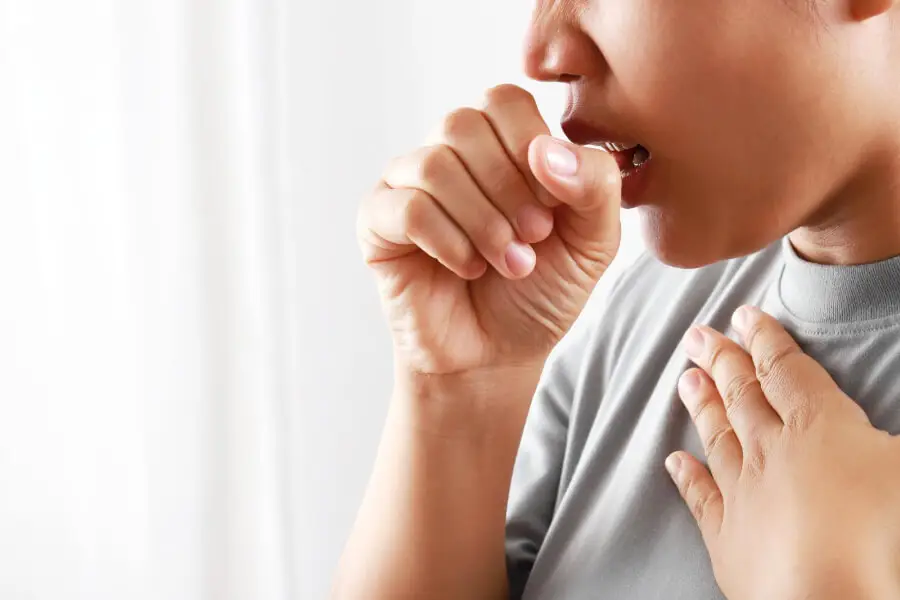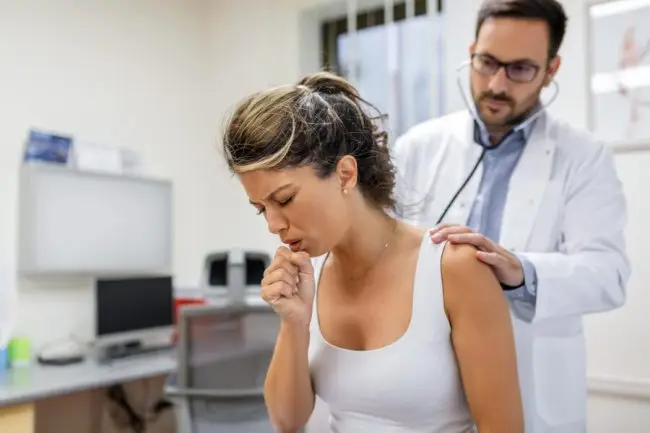Whooping cough, also known as pertussis, is a highly contagious respiratory disease.
If you suspect that you or someone you know has whooping cough, it’s important to act quickly to manage the symptoms and prevent the spread of the illness.
In this article, we’ll cover seven important steps you should take if you suspect a cough.
We’ll also discuss common symptoms, diagnosis, nighttime care, long-term effects, stages, home remedies, and answer some frequently asked questions.
What Are the Three Stages of Whooping Cough?
Whooping cough progresses through three stages:
- Catarrhal Stage: This initial stage lasts 1-2 weeks and includes mild symptoms like a runny nose, sneezing, low-grade fever, and a mild cough.
- Paroxysmal Stage: This stage lasts 1-6 weeks and is characterized by severe coughing fits followed by the characteristic “whoop” sound.
- Convalescent Stage: The final stage lasts 2-3 weeks and involves a gradual reduction in coughing fits and a slow recovery of strength and energy.
How to Cure Whooping Cough at Home
While medical treatment is essential, there are also home remedies that can help alleviate symptoms:
- Honey: Honey can soothe the throat and reduce coughing. However, it should not be given to children under one year of age.
- Hydration: Keep hydrated with water, herbal teas, and clear broths.
- Rest: Ensure plenty of rest to help the body recover.
Common Symptoms to Look Out For
Recognizing the symptoms of cough early is essential for timely intervention. Here are the common symptoms to look out for:
Severe Coughing Fits: The hallmark of whooping cough is severe, uncontrollable coughing fits that may end with a “whooping” sound when inhaling.
Runny or Stuffy Nose: Initial symptoms often resemble those of a common cold.
Fever: A mild fever may accompany the cough.
Fatigue: The intense coughing can lead to exhaustion.
Vomiting: Coughing fits can be so severe that they induce vomiting.
Diagnosing Whooping Cough
If you suspect whooping cough, getting a proper diagnosis is crucial for your health. Here are the steps involved in diagnosis:
Visit Your doctor: Schedule an appointment with your doctor if you suspect whooping cough. They will ask about your symptoms and medical history.
Physical Examination: Your doctor will perform a physical exam to check for signs of whooping cough.
Laboratory Tests: A sample of mucus from your nose or throat may be taken to test for the presence of Bordetella pertussis, the bacteria that cause whooping cough.
We’ll now discover 7 ways to look for if you have or know anyone who’s having a whooping cough.
Seek Medical Attention
The first and most important step is to seek medical attention.
If you suspect whooping cough, contact your healthcare provider immediately. Early diagnosis and treatment can help manage symptoms and prevent complications.
Isolate the Patient
Whooping cough is highly contagious, so it’s crucial to isolate the patient to prevent spreading the disease.
Keep the infected person away from school, work, and other public places until they are no longer contagious.
Follow the Prescribed Treatment
If diagnosed with whooping cough, it’s essential to follow the prescribed treatment plan.
Practice Good Hygiene
Practicing good hygiene can help prevent the spread of cough. Here are some tips:
- Wash Hands Regularly: Wash your hands frequently with soap and water for at least 20 seconds.
- Use Hand Sanitizer: If soap and water aren’t available, use an alcohol-based hand sanitizer.
- Cover Your Mouth: Cover your mouth and nose with a tissue or your elbow when coughing or sneezing.
Keep Hydrated
Staying hydrated is important, especially when dealing with a respiratory illness.
Drinking plenty of fluids can help soothe the throat and prevent dehydration caused by fever and vomiting. Water, herbal teas, and clear broths are good options.
Manage Nighttime Symptoms
It can be particularly bothersome at night, disrupting sleep.
Here are some tips to manage nighttime symptoms:
- Elevate the Head: Use extra pillows to keep the head elevated, which can help reduce coughing.
- Use a Humidifier: A cool-mist humidifier can add moisture to the air, making it easier to breathe and soothe the throat.
- Stay Calm: Coughing fits can be frightening, especially for children. Staying calm and reassuring them can help reduce anxiety and make the fits less severe.
Monitor for Complications
It can lead to complications, especially in infants, young children, and older adults.
Keep an eye out for signs of complications, such as difficulty breathing, persistent vomiting, or signs of dehydration. If you notice any of these symptoms, seek medical attention immediately.
Long-Term Effects of Whooping Cough in Adults
While it is often associated with children, adults can also be affected, and the long-term effects can be significant.
Some potential long-term effects include:
- Chronic Cough: A prolonged cough that can last for months.
- Rib Fractures: Severe coughing fits can cause rib fractures.
- Pneumonia: A common complication that requires additional treatment.
Conclusion
Suspecting whooping cough can be alarming, but taking the right steps can help manage the symptoms and prevent the spread of the disease.
By seeking medical attention, isolating the patient, following the prescribed treatment, practicing good hygiene, staying hydrated, managing nighttime symptoms, and monitoring for complications, you can effectively handle a whooping cough infection.
FAQs
What should I do if I think I have a whooping cough?
If you think you have a cough, contact a doctor immediately. Early diagnosis and treatment are crucial.
What are the steps of whooping cough?
Whooping cough progresses through three stages: the catarrhal stage, the paroxysmal stage, and the convalescent stage.
What to do if you suspect pertussis?
If you suspect pertussis, seek medical attention, isolate the patient, follow the prescribed treatment, practice good hygiene, stay hydrated, manage nighttime symptoms, and monitor for complications.
How do you rule out whooping cough?
To rule out whooping cough, your healthcare provider may perform a physical exam and order laboratory tests to check for the presence of Bordetella pertussis.






